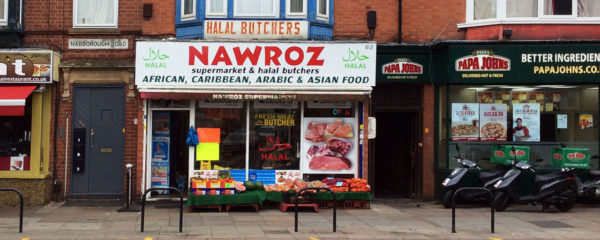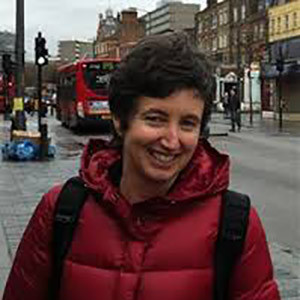Recognising the UK’s ‘super-diverse street’ – an interview with Suzanne Hall

Launched in January 2015, the ESRC-funded Urban Transformations project Super-diverse Streets: Economies and Spaces of Urban Migration in UK Cities explores the dynamics of the ‘super-diverse street’ in a selection of British cities, including Birmingham, Bristol, Leicester, London and Manchester. Described by Suzanne Hall, Principal Investigator of the research, as ‘urban ecosystems formed by the long histories of migration that have shaped cities across the UK’, they are typically situated in some of the most marginalized urban areas. As hubs of migration, arrival and growth, these streets reflect the UK’s history of Empire and its continued geopolitical global interventions and connections today.
Through a variety of innovative methods, including face-to-face surveys, interviews and detailed street-level drawings, the study has already produced a striking picture of these vital and diverse environments. In Cheetham Hill, Manchester, for instance, almost seven out of ten business owners interviewed spoke three or more languages. Similarly, in Narborough Road, Leicester, the team identified no less than 22 different countries of origin among the business owners they surveyed. ‘Proprietors,’ says Hall, ‘are notably proficient in a number of languages, frequently have tertiary education, and have experienced some other form of work’ – resulting in a ‘densely experimental and capricious urban space that is as much cultural as it is economic’. Numbering a variety of different migrant communities, from post-war workers from Commonwealth countries to those fleeing conflict, they have helped drive renewal and innovation on these streets.
However, the vitality and connections these shops, restaurants and internet cafes bring to their neighbourhoods is all too often overlooked: ‘Their forms of value seem to remain unrecognized by official forms of power,’ Hall argues. Yet the contribution of these super-diverse streets is all the more important given their location in marginalised urban areas struggling with the effects of economic contraction, austerity and deepening inequality. The benefits include ‘significant job provision in areas where unemployment is high, autonomous and rich expressions of culture that belie requirements of cohesion or assimilation, and modes of care and counsel that fill the gaps of a receding state.’
 Critically, too, the project’s findings so far have provided a valuable corrective to the simplistic image of ‘deprivation’ frequently associated with the less affluent areas of the UK’s cities. Instead, Hall’s work has demonstrated how, contrary to this narrow definition, these neighbourhoods have developed resilience in part related to the social and economic differentiation migration has created. According to Hall, ‘the economic and cultural skills on the street reveal abilities to lend and distribute money, to ride out periods of recession, to invent more dynamic forms of tenure, to develop economies refined to engage with the demands and rigidity of bureaucracy, as well as to build networks that support those most affected by austerity governance.’ These qualities are not always readily measurable in conventional terms. ‘Our streets that we studied by and large reveal an urban resilience and competence, which neither denies the structures of relegation and deprivation, nor which is wholly defined by them.’ The challenge, she concludes, ‘is to look below the categorisations of deprivation’ and recognize the considerable efforts and achievements in evidence despite the barriers of inequality and discrimination.
Critically, too, the project’s findings so far have provided a valuable corrective to the simplistic image of ‘deprivation’ frequently associated with the less affluent areas of the UK’s cities. Instead, Hall’s work has demonstrated how, contrary to this narrow definition, these neighbourhoods have developed resilience in part related to the social and economic differentiation migration has created. According to Hall, ‘the economic and cultural skills on the street reveal abilities to lend and distribute money, to ride out periods of recession, to invent more dynamic forms of tenure, to develop economies refined to engage with the demands and rigidity of bureaucracy, as well as to build networks that support those most affected by austerity governance.’ These qualities are not always readily measurable in conventional terms. ‘Our streets that we studied by and large reveal an urban resilience and competence, which neither denies the structures of relegation and deprivation, nor which is wholly defined by them.’ The challenge, she concludes, ‘is to look below the categorisations of deprivation’ and recognize the considerable efforts and achievements in evidence despite the barriers of inequality and discrimination.
While Hall describes super-diverse streets as the ‘embodied antithesis’ of the recent vote for the UK to leave the European Union, she does not anticipate that the result will directly affect the composition of the street, in part because the proportion of proprietors from Europe in the areas they studied is relatively small. Nevertheless, the broader implications for the multicultures that have sustained them remain troubling. ‘Brexit is an accumulation of conservative politics that will and does impact on streets and society: from the marked anti-migration shift in public consciousness and the escalation of punitive immigration laws, to the lack of political willingness to engage with mobility as an integral part of 21st century citizenship.’ However, the complex life of the super-diverse street demonstrates just how important migration has been to the UK’s development in the last few decades – and the very real cost that greater restrictions could bring to cities across the country.